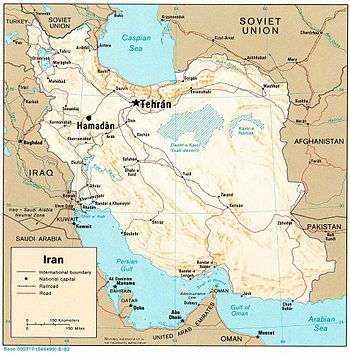1976 Tehran UFO incident

The 1976 Tehran UFO Incident was a radar and visual sighting of an unidentified flying object (UFO) over Tehran, the capital of Iran, during the early morning hours of 19 September 1976. During the incident, two F-4 Phantom II jet interceptors reported losing instrumentation and communications as they approached the object. These were restored upon withdrawal.
One of the aircraft also reported a temporary weapons systems failure while the crew was preparing to open fire.
Explanation and analysis
According to Martin Bridgstock of Griffith University:[1]
| “ | Stripped of details, a couple of F4 jets from the Iranian airforce were scrambled to investigate some sightings of lights in the sky. Reports vary, but at least one jet suffered grave electrical failures, tried to fire a missile at something and had something fired at it. A nearby jet airliner also suffered radio failure. | ” |
According to journalist Philip J. Klass, it was likely the pilots initially saw an astronomical body, probably Jupiter, an explanation also cited by aerospace researcher James Oberg. Klass wrote that pilot incompetence and equipment malfunction likely accounted for the reported equipment failures.[2]
According to Klass, the Westinghouse technician at Shahrokhi airbase stated that only the first F-4 reported failing equipment, and that this F-4 was known for equipment failures with a long history of electrical outages, having been repaired only a month before the incident. Klass cites a McDonnell Douglas repair supervisor's opinion that the F-4's radar could have been in "manual track" mode, causing a wrong interpretation of the radar lock.[2]
Bridgstock criticized UFOlogists reports as "not a reliable account of the Iran UFO incident" and summed up Klass' conclusions:[1]
| “ | Klass found that only one aircraft had suffered electrical malfunctions, not two. What is more, that plane had had a history of unexplained electrical faults, and the electrical workshop responsible for it was notorious for poor performance. In this context, a temporary electrical malfunction can hardly be characterised as mysterious. He also points out that the aircrews at the time were tired and rattled, and could have mistaken stars or meteors for UFOs and“missiles”. In addition, Klass points out that radio faults on airliners are not unknown, and that is why they carry backup radio sets. | ” |
Regarding pilot reports of "bright objects" falling to the ground and "leaving a bright trail", author Brian Dunning observes that September 19, the day of the incident, was the height of two annual meteorite showers, the Gamma Piscids and the Southern Piscids and the tail of the Eta Draconids shower, so observation of falling objects or odd lights would not have been unusual. At the site where the falling light supposedly crashed, a beeping transponder from a C-141 aircraft was found according to investigating Col. Mooy.[3]
According to Dunning:[3]
| “ | Once we look at all the story's elements without the presumption of an alien spaceship, the only thing unusual about the Tehran 1976 UFO case is that planes were chasing celestial objects and had equipment failures. There have been many cases where planes had equipment failures, and there have been many cases where planes misidentified celestial objects. Once in a while, both will happen on the same flight. | ” |
Dunning criticized UFOlogists and UFO-themed television programs like Sightings for describing all the events related to the incident "from the context of a presumption that the light was a hostile and intelligently guided alien spacecraft".[3]
Reference to incident in the media
- The Sightings TV program covered the incident in 1994, interviewing many of the participants.
- The Telegraph's top 10 UFO sightings (#7).[4]
- The Guardian's top 10 UFO sightings (#10).[5]
Gallery
Editorial published in the United States Air Force Security Services quarterly MIJI (Meaconing, Intrusion, Jamming, and Interference) newsletter that is "often waved by the UFOlogists as compelling evidence". According to Brian Dunning, "because this service requires a security clearance, their newsletter is protected as well. There is nothing especially interesting about the actual article; it's just a dramatized retelling of the same information in Col. Mooy's memo, offered in the newsletter as a curious editorial on the subject of jamming and interference."[3]
 Editorial from the US Air Force MIJI newsletter (page 1)
Editorial from the US Air Force MIJI newsletter (page 1) Editorial from the US Air Force MIJI newsletter (page 2)
Editorial from the US Air Force MIJI newsletter (page 2) Editorial from the US Air Force MIJI newsletter (page 3)
Editorial from the US Air Force MIJI newsletter (page 3)
See also
References
- 1 2 Martin Bridgstock. Beyond Belief: Skepticism, Science and the Paranormal. Cambridge University Press; 20 October 2009. ISBN 978-1-139-48254-7. p. 125–.
- 1 2 Philip J. Klass (1 January 1983). UFOs: The Public Deceived. Prometheus Books. ISBN 978-0-87975-322-1.
- 1 2 3 4 Dunning, Brian (19 June 2012). "Skeptoid #315: The Tehran 1976 UFO". Skeptoid. Retrieved 22 June 2017.
- ↑ Otto, Sasjkia (17 August 2009). "UFO Files: top 10 UFO sightings". The Daily Telegraph. London.
- ↑ Michael Hogan. "Top 10 UFO sightings: from Roswell to a pub in Berkshire | World news". The Guardian. Retrieved 2015-12-17.
External links
- The Tehran UFO incident report at UfoSightingsToday.org
- Defence Intelligence Agency Report with Routing and Transmittal Slip
- Defense Intelligence Agency Report
- Dunning, Brian (19 June 2012). "Skeptoid #315: The Tehran 1976 UFO". Skeptoid. Retrieved 22 June 2017. Podcast citing the various problems with the incident.
- NICAP.org: Iran F-4 Incident Archived 6 February 2006 at the Wayback Machine.